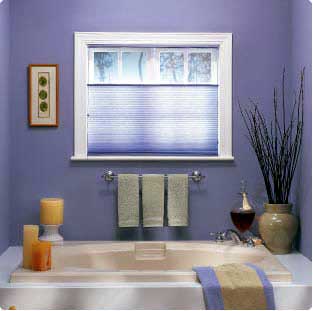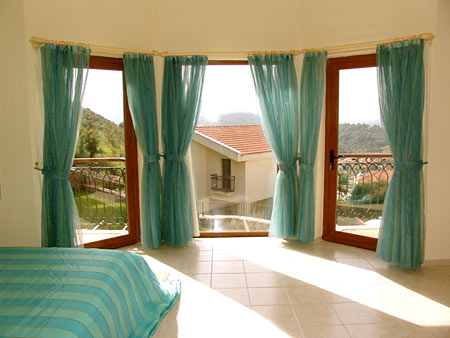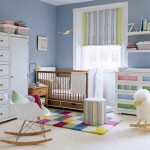December 10th, 2008
If you could design the ideal bedroom, it would be large enough to hold whatever size bed you desire, with ample room for modern furniture and accessories. Unfortunately, many times the case is just the opposite; once the bed is chosen and in place, you’re faced with trying to fit everything else into the remaining space without overcrowding.
Taking time to plan can help you to foresee any possible space usage problems. Begin by surveying your existing bedroom, then analyze your options for improvement. Study the layout of the space and think about how it can work best for you. A good design is practical and comfortable, as well as stylish.
Because the bed is usually the largest item in the room, its location is critical to making the most effective use of the space. Traffic patterns begin and end at the bed. The location of other areas, such as a dressing or sitting area, will then evolve from the bed’s placement. Start experimenting with your floor plan options by trying various modern furniture arrangements on paper instead of trying to push heavy furniture around the room.
Try to imagine being in your bedroom with the type of bed you want, placed where you think it works best. Does this new floor plan make the most efficient use of floor space?
Think about what you will see from the bed. Will morning light waken you or glare into your eyes? Allow enough clearance in places where a door swings inward or a drawer pulls open. Be sure to allow enough clearance above the bed as well, especially with a platform bed. Four feet of headroom is the minimum that should be allotted.
To create the illusion of a larger space, avoid clutter. Keep as much floor area open as possible. Placing the bed in a corner is one way to make the rest of the floor area seem larger. A studio apartment or a small bedroom can double as a sitting room by using a sofa bed, futon couch or daybed (a bed with two ends) rather than a conventional bed.
The guidelines for bedroom furniture arrangements are more flexible because these rooms don’t have as much traffic as other rooms. These guidelines allow you to use some tricks to help make a bedroom more useful. Beds can be free-standing, positioned with one end or side against the wall, angled into the room, or tucked into a corner or a special niche. If you’re dealing with limited floor space or a seldom-used guest room, a loft bed, bunk bed, Murphy bed, trundle or other built-in may be the answer.
Tags: Bedroom, design, floor
Posted in Bedroom | No Comments »
December 9th, 2008
Sometimes it’s not sun but the curiosity of neighbors that you wish to thwart. To create privacy without vanquishing the sunlight, you can try to install simple white shades that pull up from the bottom. (Any window-treatment specialist can install shades this way.) When halfway up, they grant privacy while giving you a glimpse of the sky.

Tags: Bedroom, privacy, shades, windows
Posted in Bedroom | 1 Comment »
December 9th, 2008
Begin by assessing your existing bedroom. What needs are being met, and what is lacking? What do you like or dislike? Do you want more morning light? More storage space? Have your space needs changed? Have the kids moved out so you have extra space? Or have you added to your family, creating new space needs?
 If you’re starting from scratch your options are wide open; you have the luxury of choosing the size and location, even the layout of your bedroom. On the other hand, if you’re dealing with a bedroom that already exists, there is a good chance you will be limited by space and layout restrictions. Although your options may seem limited, there are more alternatives to choose from than one might think.
If you’re starting from scratch your options are wide open; you have the luxury of choosing the size and location, even the layout of your bedroom. On the other hand, if you’re dealing with a bedroom that already exists, there is a good chance you will be limited by space and layout restrictions. Although your options may seem limited, there are more alternatives to choose from than one might think.
Because bedrooms are such personal rooms, not usually seen by many outsiders, they often evolve into one of the most eclectic rooms in the house. A bedroom is often the place where you’ll find collections of personal art and memorabilia, photographs, even a favorite piece of furniture, all tied together into one harmonious look-sometimes depicting a specific style, sometimes just an overall feel or theme. Decorative elements such as style, color, pattern and texture will also play a part in the final look you create.
Often we are limited by budget constraints when remodeling. There are a number of simple improvements that can be made in a bedroom that don’t cost a lot, and will achieve very effective results. Altering the floor plan and redefining the space can make what you already have more usable and efficient. If structural changes aren’t possible at this time, easy updates like replacing old wallpaper, adding recessed lights or installing plush new carpet can breathe new life into an old bedroom. This type of remodel won’t solve any space constriction problems, but the changes are easy and can do almost as much for the look of a bedroom as rearranging the walls-at half the cost.
A structural change is the most effective way to make a dramatic difference in an existing bedroom. A new bay window or a walk-in closet can change the entire feel of the room.
Tags: Bedroom, design, planning
Posted in Bedroom | 2 Comments »
December 8th, 2008
Darkness on Sunday mornings. Bright sun on Monday. Privacy from the neighbors, but also a view we do ask a lot of our bedroom curtains. And it helps, of course, if they have a romantic or peaceful quality that makes the bedroom more of a sanctuary. Not every trade secret in this chapter can meet all these requirements. Depending on your needs, you may have to (a) prioritize or (b) combine treatmentsâ€â€using, for example, an opaque shade behind a sheer drapery.
Now for the easy part: You can dress a bedroom window with less effort than a window in a living or dining room. Consider a blowsy length of gauze tossed over a rod: in the living room, it can look insubstantial, but in the bedroom, it suggests a veil. Delicacy works in the privacy of a bedroom, and delicate fabrics (think linen, lace, and sheers) are often reasonably priced.

Simplicity works, too. A surprising number of houses and apartments by top designers have bedroom windows dressed only in pristine white schoolhouse shades, the kind you may recall from your third-grade classroom, If the shades are custom-made for a tailored fit, you’ll find that the understatement works.
Try not to overcoordinate. If you make curtains to match your patterned sheets, the room will look predictableâ€â€and after a while you’ll tune out that gorgeous pattern. Let window treatments stand on their own. If you still crave coordination, do something overscaled and unexpected: cut an 18-inch-high band from the patterned sheets and sew it across the base of starched white curtains. You’ll have broken out of a formula, and the details of your decorating will stand out the better for it.
Tags: Bedroom, curtains, windows
Posted in Bedroom | No Comments »
December 8th, 2008

The old-fashioned nursery had the right basic ideas. It was essentially a room given over to children for which most parents were content to provide, if they could, a well-ventilated space with somewhere to sleep, plenty of floor/play space, somewhere to sit, some sort of games, drawing, work surface and reasonable storage.
In a sense this sort of framework is still in force today - but with some big differences. First, many of the clever and colorful ideas produced for nursery and primary schools to provide inÂÂtellectual stimulus for their pupils have begun to trickle back into the home in the form of educational playÂÂthings, body-building structures and early learnÂÂing apparatus. And second, children today belong to a techÂÂnologically sophisticated generaÂÂtion where the computer is becomÂÂing as commonplace as the teleÂÂvision, and where audio-visual equipment replaces building bricks and snakes and ladders almost as a matter of course.
This means that any forward planning at the infant stage should involve thinking at least about the probability of having to make room for such things. While it is imposÂÂsible to project several years ahead and visualize exactly what amazing new inventions are going to invade our lives, let alone what size and shape they are going to be or how many extra electric points and outÂÂlets they’ll need, what you can do is think in terms of flexible arrangeÂÂments in the home.
Parents of young infants will find it difficult to imagine anything at all beyond the immediate world of nappies and feeds, cots and baths but it doesn’t last forever and if that’s all they’ve planned for, they’ll find the room soon outÂÂgrown and unsuitÂÂable for the next stage in their children’s lives. The time, money and effort spent on creating a room the chilÂÂdren don’t want to use will be wasted.
So, when you are faced with this empty room that you want to take care of your children’s needs for the next eighteen years, rememÂÂber, as you make your plans, that adÂÂaptability is the name of the game.
Tags: Bedroom, children, design, planning, room
Posted in Baby Kids Furniture | No Comments »


 If you’re starting from scratch your options are wide open; you have the luxury of choosing the size and location, even the layout of your bedroom. On the other hand, if you’re dealing with a bedroom that already exists, there is a good chance you will be limited by space and layout restrictions. Although your options may seem limited, there are more alternatives to choose from than one might think.
If you’re starting from scratch your options are wide open; you have the luxury of choosing the size and location, even the layout of your bedroom. On the other hand, if you’re dealing with a bedroom that already exists, there is a good chance you will be limited by space and layout restrictions. Although your options may seem limited, there are more alternatives to choose from than one might think.

